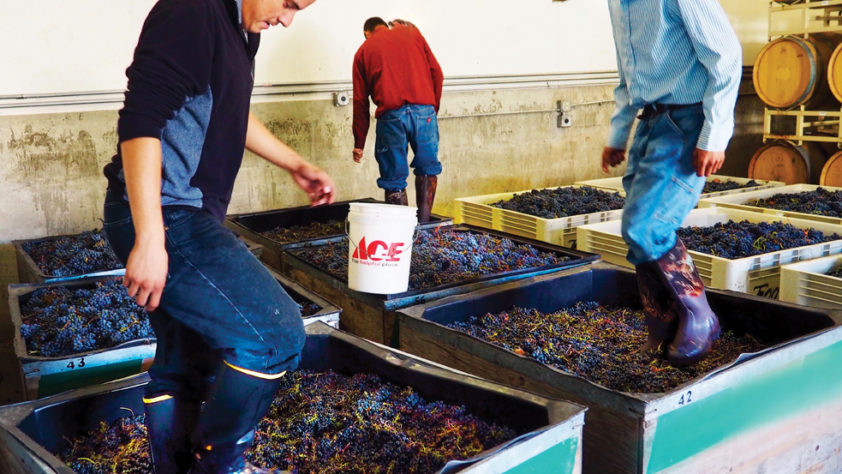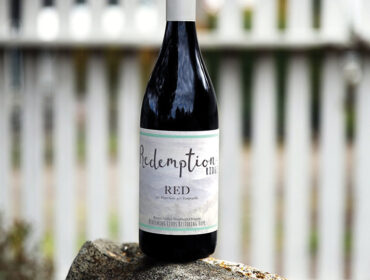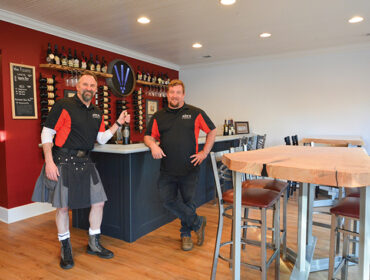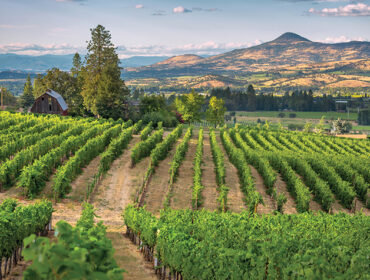
Troon Vineyard Digs Deep into Biodynamic Viticulture – by Rhonda Nowak
Traveling along Highway 238 in the upper Applegate Valley is like driving straight into a landscape painting. Only this idyllic scenery is not on canvas, it’s real with added sensory pleasures of pine trees and a soft afternoon breeze drifting over the Siskiyou Mountains.
Within these picturesque surroundings, Troon Vineyard is nestled on the Kubli Bench at 1,400 feet above sea level, where the valley opens up for the Applegate River to continue its journey toward the Pacific Ocean some 50 miles away. Here, the ancient granitic and river sediment soils supporting Troon’s vineyards share similarities with renowned viticulture regions of France and Italy—Alsace, Beaujolais, the Languedoc and Sardinia—places that provide inspiration for Troon’s estate wines.
Yet, Craig Camp, Troon’s general manager since 2016, is quick to point out the distinctiveness of Troon’s terroir. He has extensive knowledge of wines that express unique characteristics of place, having spent the last 35 years in Italy, Napa Valley, Willamette Valley, and the Applegate Valley.
Along with climate, fertile soil is a critical component of fine wine-producing terroir, and that is the reason behind Troon’s decision last year to transition to biodynamics, a controversial philosophy and method of agriculture that is, nevertheless, increasingly acclaimed by top vineyards all over the world.
In addition to farms that grow produce other than grapes, there are currently 14 vineyards/wineries in Oregon certified as biodynamic, with the highest percentage of BD-certified vine acres in the U.S. Cowhorn Vineyard and Garden in the Applegate Valley is the only certified biodynamic vineyard in Southern Oregon right now; however, Camp aims to add Troon to the shortlist of BD certified vineyards by 2020.
With guidance from a California-based biodynamic consultant, changes at Troon began soon after Bryan and Denise White of Arlington, Texas purchased the 100-acre estate in November 2017. “Nothing worthwhile in life is ever easy; biodynamic farming is no exception,” Bryan said. “We believe the holistic principles of biodynamics will provide the framework needed for our conversion from conventional farming to a biodynamic-certified vineyard.”
Troon switched to using minimalist methods for winemaking in 2014. These include crushing grapes by foot, using only native, natural yeasts, and avoiding the use of additives during fermentation, such as acids, sugar, tannins and sulfur. “We’re using the old ways of making wine,” Camp noted. Additionally, Troon’s vineyards are LIVE (Low Input Viticulture and Enology) and Salmon-Safe certified.
Still, Camp said past years of conventional farming practices have taken a toll on Troon’s soil, and the use of biodynamic practices is expected to help restore the soil to its full potential. “Biodynamics is a science of life forces,” said BD consultant Andrew Beedy, “a recognition of the basic principles at work in nature, and an approach to agriculture which takes these principles into account to bring about balance and healing.”
Camp is chronicling Troon’s process of converting to biodynamics on his blog, Wine Camp (www.winecampblog.com), where he posted, “I know that if we can bring our soils back to life, we can take our already very good wines to even higher levels of quality; in fact, to true greatness.”
So what is biodynamic farming, and why has it raised so many eyebrows in the wine industry? “I think of it as organic agriculture with essential composting, plus proactive, probiotic applications,” Camp explained.
In fact, BD certification requires use of nine preparations (labeled 500 through 508), which are made with cow manure, herbs or other plant materials, and applied to compost piles or directly on grapevines and other crops (see sidebar). Each infusion contains microorganisms that help restore the soil’s vitality and, as Camp noted, the soil’s potential for growing strong, healthy grapevines naturally resistant to insect pests and diseases. Healthy vines are essential for flavorful fruit and world-class wines, Camp said.
Developing the biodynamic preparations and applying them must meet stringent standards set by Demeter International, the non-profit organization that began BD certification programs in Germany in 1928. One of the most questionable methods involves burying cow horns filled with manure in 5-feet deep pits to make BD preparation 500, a mixture Camp referred to in his blog as “the really good shit.”
Another important aspect of biodynamics is timing crop production and processing with the rhythms of the moon, in observance of the age-old belief that lunar phases affect plant growth. Taking this idea further, biodynamic advocates say wine, as a living organism, also responds to the moon’s rhythms. Accordingly, they argue wine tastes better on days when the moon passes through constellations associated with air (flowers) and fire (fruit).
Critics of biodynamics say the benefits of using BD methods lack scientific support, and the techniques are more symbolic than practical.
Yet, more and more biodynamic vine tenders and winemakers are responding to jibes about their “voodoo viticulture” by showing improved soils, vines and wines. Many came together last May when Demeter USA sponsored the first U.S.-hosted International Biodynamic Wine Conference in San Francisco. The Biodynamic Association also provides a research reference portal on its website (www.biodynamics.com).
Camp said everyone at Troon—including vineyard foreman Adan Cortes and winemaker Steve Hall—is excited to participate in a more holistic approach to winemaking, and to watch how the microbiome of the estate’s soil changes. “It’s clear that biodynamics makes better wine, but we want to learn more about how and why,” he said.
So far, Troon’s transition to biodynamics has entailed conducting an electromagnetic soil scan and analysis, using new weed-control machinery, building compost piles with manure supplied by Troon’s neighbor, Noble Dairy, an organic farm, and applying BD preparations to the compost piles and vineyards.
However, Camp pointed out that many of the changes taking place at Troon are within the people who work there. He posted on his blog, “Biodynamics will reinvigorate our soils and our vines, but it is also reinvigorating us. It is those combined energies that will be expressed in our wines.”
It sounds like there are many kinds of shifts taking place right now at Troon Vineyards, as biodynamic’s founder Rudolf Steiner put it, “deep at the roots of things.”
Biodynamic agriculture is (re)born
In 1924, Austrian philosopher Rudolf Steiner presented a series of lectures titled “Spiritual Foundations for the Renewal of Agriculture” to a group of anxious farmers who had gathered in Koberwitz, Silesia (now part of Poland). The farmers were concerned about the effects of new agricultural practices that had sprung up in Central Europe (and elsewhere in the world) after WWI, which called for the use of “innovative” chemical fertilizers and herbicides to increase crop yields and reduce weeds.
Steiner, best known in the U.S. as the founder of the arts-based Waldorf School curriculum, had spent most of his adult life writing and lecturing on a variety of topics: social reform, education, medicine, literature, agriculture and many others. His views on natural and self-sufficient farming methods were directly opposed to the new practices, which turned out to be harbingers of the agro-industrial monoculture model of farming that is commonly implemented throughout the world today.
During his speeches, Steiner reinforced what the farmers already knew from experience: healthy crops are grown from healthy soil that is continually replenished by composting green waste and animal manure produced on site.
Although based on agricultural methods that have been used for millennia, Steiner’s lectures became the cornerstone of a “new” approach to cultivation called biodynamics. Demeter International (Demeter refers to the Greek goddess of grain and fertility) was established in Germany in 1928, and today certifies agriculture in more than 50 countries.
In the United States, the Biodynamic Farming and Gardening Association (now the Biodynamic Association) was formed in New York in 1938. Demeter USA was incorporated in 1985 with headquarters in the Willamette Valley.
Biodynamic certification requires nine preparations that must meet stringent guidelines for production and application. Except for 500 and 501, all of the materials are plants that have long been used for healing purposes:
500 – manure composted in cow horns
501 – cow horn silica (mixed with manure)
502 – yarrow flowers (Achillea millefolium)
503 – chamomile flowers (Matricaria chamomilla)
504 – stinging nettle stems (Urtica dioica)
505 – oak bark (Quercus)
506 – dandelion flowers (Taraxacum officinalis)
507 – valerian flowers (Valerian officinalis)
508 – horsetail (Equisetum hyemale)
Find out more about biodynamic agriculture on Demeter USA’s website: http://www.demeter-usa.org/.
©Southern Oregon Wine Scene
Fall Winter 2018 issue
Related Post
RoxyAnn Winery–Making a Difference with Redemption...
Update to this article on 07/29/21 – “… the Board of Directors of Redemption Ridge have made the difficult decision to clo...
Awen Winecraft: An Inspirational New Reason...
As if you needed another reason to visit historic Jacksonville, now there’s another draw—Awen Winecraft’s new tasting room located at ...
Rogue Valley Rising – by Valerie...
MEDFORD, OREGON’S star is rising on the world stage as it rapidly becomes a top destination for connoisseurs of fine wine and for enthusia...




